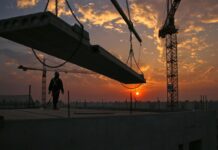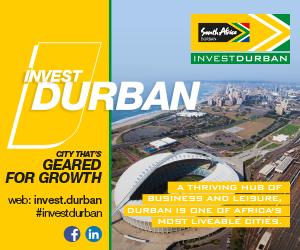
By John Young
As 2023 drew to a close, concerns about the functioning of South Africa’s ports and railways became more urgent. Transnet, the state-run utility which has six divisions covering ports, port terminals, railways, engineering, pipelines and property, is investigating partnerships with private operators, but the immediate priority is to fix dockside cranes and unload ships.
President Cyril Ramaphosa himself visited the Port of Richards Bay, and promised swift action. The inability of the state’s other big utility, Eskom, to ensure a reliable supply of electricity has been a concern for some time.
In response to these large national problems, the Chief Executive Officers of 130 South African companies have made a joint commitment to help. In addition to logistics and energy, crime is the third area of focus for a series of Working Groups which regularly meet and report to the President every six weeks. Calling itself “Business for South Africa”, the group first came together in response to the Covid pandemic in 2020 and helped to coordinate the successful vaccination rollout of 2021. Spokesmen for the grouping have said that they are responding to national priorities in the spirit of building a prosperous future together.
Boosting efficiency at ports
The first steps in a move by the state to partner with the private sector in boosting efficiency at ports were taken in 2022: deals were signed at the Port of Durban, Richards Bay and at East London. In 2023, these first steps became a giant leap when International Container Terminal Services Inc (ICTSI), a Philippines-based port operator, was announced as the preferred partner for a joint venture (JV) to run the Durban Container Terminal with Transnet.
Part of the plan for Durban Container Terminal Pier 2 is to increase traffic in such a way that it will be able to increase its handling capacity from the present 2.9-million TEUs (two-million 20-foot equivalent units) to 11-million TEUs by 2032.
The 2022 deal involving a 15-year concession for the loading of grain at one of Durban’s agricultural terminals was won by Afgri, one of South Africa’s biggest agricultural firms. Afgri will deal with the operation and maintenance of all landside operations, and the deal includes a similar arrangement at East London. The other two terminals in Durban are operated by SA Bulk Terminals and Bidvest Bulk Terminals.
A similar plan to concession certain dedicated rail lines to private operators has not gone smoothly. The private sector was initially very interested in the idea of running currently closed branch lines to a railhead delivering grain in the Free State or coal in Mpumalanga, for example. However, the length of contract time offered to the private operators was not long enough for them to feel it was worth their while. There was only one bid so the whole process has been put on hold while the model is reworked.
Seeing opportunity in a crisis
The conversation about the global climate crisis has seized the limelight across the world in a way that few other topics have since World War II. The debate in South Africa has its own unique contours, particularly as so much of the country’s electricity generation comes from coal, about 80%. The fact that many people would lose their jobs if coal mines close down is an important factor in calculations, and a key reason why South Africa is at the forefront about the need for a “Just Energy Transition”.
In addition to this, Eskom has not been able to avoid regular power cuts. An excellent programme exists to procure the energy that South Africa needs to expand the economy, the Renewable Energy Independent Power Producer Procurement Programme (REIPPPP). In Round Five of the REIPPPP, the cheapest solar generation cost was 37.5c/kWh while the best wind cost was 34.4c/kWh. These represent remarkably low costs.
When President Ramaphosa announced that private power investors could create up to 100MW of power without having to wait for licensing, he potentially opened up a path to growth.

The utility’s inability to provide enough electricity to power the economy (and its huge debt) rank as the biggest risks to the South African economy. Opportunities for private consortiums are expanding and every window of the REIPPPP has been oversubscribed so there is an appetite to enter the South African energy market.
Eskom’s unbundling will be another spur to growth. The legal separation of transmission is the first step, and considerable progress was made on this in 2023.
The Northern Cape has attracted the bulk of solar projects, and the Eastern Cape has become the home of the wind farm, but the Western Cape has a good mixture of both modes of renewable energy. It also has an enthusiastic metropole, Cape Town, and a provincial administration determined to take full advantage of nature’s bounty. Following the announcement by the City of Cape Town that residents could get cash for power in late 2022, Versofy Solar received 1 500 enquiries in the month of January and has experienced a surge of orders for rooftop installations since then.
In 2023 a major wind farm project was announced for Mpumalanga, proving that preconceptions about renewable energy resources in that province were wrong.
Eskom’s unbundling will be another spur to growth. The legal separation of transmission is the first step, and considerable progress was made on this in 2023. The other two elements, generation and distribution, will follow. The idea is not to privatise the entities but to find private partners and to allow for competition within the various fields.
The R130-billion pledged at COP26 by the EU, the US, Germany, France and the UK to assist South Africa’s transition from oil and coal to greener technologies is not straightforward; it comes as a mixture of grants, risk-sharing instruments and concessional finance but it will allow South Africa to fund projects that will help the country to move away from fossil fuels without further stretching Eskom’s precarious finances.
The R130-billion pledged at COP26 by the EU, the US, Germany, France and the UK to assist South Africa’s transition from oil and coal to greener technologies is not straightforward…
Eskom made a breakthrough in December 2022 when South Korean company Hyonsung Heavy Industries broke ground at Elandskop signalling the first project in Eskom’s Battery Energy Storage System (BESS) project. The 8MW facility will move to producing an additional 144MW in the second stage of the project. In 2023, a larger project at Worcester, Hex BESS, was launched. Another company that will be involved in Phase 1 of the national rollout of these projects is Chinese company Pinggao.
In Cape Town a Swedish firm has spent $30-million setting up an assembly factory for lithium batteries and Bushveld Energy, a subsidiary of Bushveld Minerals, is producing vanadium battery electrolyte at its factory in East London. An Eastern Cape project involving nascent local utility Earth & Wire expects to start delivering batteries in the first half of 2024. US firm Ambri has the contract to deliver a 300MW/1 200 MWh battery system for a combined wind and solar system near Humansdorp.

Traditional sectors
Gold mining is declining in volumes (even while prices rise), platinum group metals (PGM) prices have gone off the highs experienced during and immediately after Covid, but major activity is still underway in the sector. Vedanta Zinc International’s project in the Northern Cape may the catalyst for the establishment of a Special Economic Zone (SEZ) and an uptick in other mining investment. Already, copper mines in that province are being revived.
The biggest mining news in 2023 was that De Beers Venetia Diamond Mine started producing. This long-term conversion project of the mine to an underground mine will extend its life to 2045 and perhaps beyond.
Sibanye-Stillwater, which quickly became a major player in PGMs, continues to acquire assets in the green metals and processing cluster while Afrimat, best known for many years for concrete and construction materials, has built up a much more varied portfolio by buying mines in three provinces. In June 2023 it went back to its roots in a sense: the company’s Construction Materials division was enlarged by the purchase of Lafarge South Africa Holdings.
The biggest mining news in 2023 was that De Beers Venetia Diamond Mine started producing. This long-term conversion project of the mine to an underground mine will extend its life to 2045 and perhaps beyond.
Grain crops such as maize, wheat, barley and soya beans are among the country’s most important crops. Only rice is imported. Wine, corn and sugar are other major exports. Basing economic growth on a devaluing currency is not the best long-term method of boosting economic growth, but high-value agricultural exports and increased numbers of high-spending international tourists hold some promise for helping to get the South African economy back on a growth path.








